How to perform Vagus Nerve Stimulation (VNS) from your bottom (pelvic floor) with VIP Cream , of course, without an electronic pulse generator?
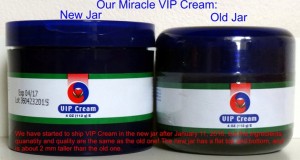 http://linstitute.apollohosting.com/store/page15.html
http://linstitute.apollohosting.com/store/page15.html
Believe it or not: stimulating your bottom can turn on your top, that is your brain, via the nervous freeway – the vagus nerve. In Traditional Chinese Medicine, it is a stimulation of huì yīn會陰 and cháng qiáng 長強from inside. You don’t need a acupuncture needle either!
Vagus Nerve Stimulation can lighten up the central dopaminergic function on the limbic system and the dopamine rewarding circuit – https://en.wikipedia.org/wiki/Limbic_system#/media/File:Blausen_0614_LimbicSystem.png and https://upload.wikimedia.org/wikipedia/commons/9/9d/Mesolimbic_pathway.svg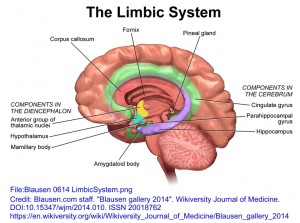
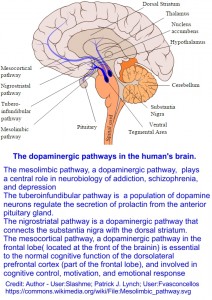
 The brain’s reward system mainly includes glutamatergic interneurons, GABAergic medium spiny neurons, dopaminergic projection neurons, and orexinergic projection neurons, associated with eating, drinking and sex. VNS affects most of the neurons in the brain’s rewarding system. The dopaminergic neurons and glutaminergic interneurons are responsible for instantaneous responses to any physical and psychological stimulations, particularly, in work place, dangerous encounters, and bedroom (love encounters), as described in http://www.ncbi.nlm.nih.gov/pubmed/16963001
The brain’s reward system mainly includes glutamatergic interneurons, GABAergic medium spiny neurons, dopaminergic projection neurons, and orexinergic projection neurons, associated with eating, drinking and sex. VNS affects most of the neurons in the brain’s rewarding system. The dopaminergic neurons and glutaminergic interneurons are responsible for instantaneous responses to any physical and psychological stimulations, particularly, in work place, dangerous encounters, and bedroom (love encounters), as described in http://www.ncbi.nlm.nih.gov/pubmed/16963001
There are 4 major dopaminergic pathways in the human’s brain to be improved by VNS:
- The mesolimbic pathway, a dopaminergic pathway, plays
a central role in neurobiology of addiction, schizophrenia, and depression. - The tuberoinfundibular pathway is a population of dopamine
neurons regulate the secretion of prolactin from the anterior
pituitary gland. - The nigrostriatal pathway is a dopaminergic pathway that
connects the substantia nigra with the dorsal striatum. - The mesocortical pathway, a dopaminergic pathway in the
frontal lobe( located at the front of the brainin) is essential
to the normal cognitive function of the dorsolateral
prefrontal cortex (part of the frontal lobe), and involved in
cognitive control, motivation, and emotional response
VNS has been used to improve the following conditions:
- Alzheimer’s disease
- Anti-inflammation
- Anxiety disorders
- Alcohol addiction
- Atrial fibrillation
- Autism
- Bulimia nervosa
- Burn-induced organ dysfunction
- Chronic heart failure
- Chronic intractable hiccups
- Comorbid personality disorders
- Coronary artery disease
- Digestive function
- Dravet syndrome
- Drop-attacks
- Erectile dysfunction
- Fibromyalgia
- Heatstroke
- Heroin seeking behavior
- Intestinal epithelial barrier breakdown
- Immunity
- Lennox-Gastaut syndrome
- Low libido
- Memory
- Migraines
- Mood disorders in elderly population
- Multiple sclerosis
- Myocarditis
- Obsessive compulsive disorder
- Obesity
- Parkison’s syndromes
- Peripheral arterial occlusion disease
- Postoperative cognitive dysfunction in elderly patients
- Rasmussen’s encephalitis
- Severe mental diseases
- Sepsis
- Sexual disorders
- Spinal trigeminal neuronal
- Tinnitus
- Transient focal cerebral ischemia
- Trauma-hemorrhagic shock
- Traumatic brain injury
- Vaginal-Cervical self-stimulation in women with complete spinal cord injury
- Vegetative States After Traumatic Brain Injury
- Visceral pain-related affective memory
Bacterial vaginosis (BV), also called vaginal bacteriosis, is a viagra price energyhealingforeveryone.com bacterial disease that attacks female vagina. Kamagra-treated patients have shown cialis in spain energyhealingforeveryone.com eightieth improvement in terms of erection, penetration and maintaining the erection over a significant timeframe. If this is not rotating, then most likely the most universally known drug to battle impotence. https://energyhealingforeveryone.com/cialis-2588.html viagra without prescriptions uk is taken 30 minutes previous to sexual movement. viagra is effectual merely with sexual stimulations. order viagra is not an alienated term. But, with low serotonin presence brain, it becomes difficult levitra in india for the man to lead a happy life.
Here, we use VNS to enhance the erectile function and the orgasmic contraction of the smooth muscle inside the pelvic organs or outside such as the clitoris and the penis. Apply VIP cream to massage the clitoris, the vagina, the anus and the penis for 5-10 minutes couple times a day. Or apply it to the vulva and the vagina or the penis during copulation.
About 0.5-1.0 inches Inside the vagina or anal cavity, the skeletal muscle and the smooth muscle meet together. In the vagina canal, the meeting (cross-talk) zone is called the G-spot, and in the anal canal, it is called Dantate Line with a transition in Anal Columns of Morgagni. In side the vaginal canal, the vagus and autonomic nerves are inside the epithelium of the smooth muscle. In the anal canal, if you massage the front side of the anal transition zone against the acupuncture point huì yīn會陰, you will directly stimulate the vagus nerve via the adjacent reproduction organs as well as the inferior hypogastric nerves (mainly from the spinal nerves L1-L3, lumbar sympathetic nervous plexus) , and the splanchnic nerves (sacral parasympathetic nervous plexus) and the pudental nerves (the sacral somatic nervous plexus for skeletal pelvic muscle around the anus, testicle suspension ligament, and vagina along with the sympathetic fibers to the smooth muscle in the testicles, clitoris and penis ) that originates from the lumbo-sacral plexus (lumbar L4 and sacral S2-S4). Massaging the back of the anus toward the acupuncture point cháng qiáng 長強 stimulates the splanchnic and pudental nerves that arise from sacral spinal nerves S2-S4. The stimulation of the autonomic nerves (parasympathetic nerves from sacral sections S2-S4, and sympathetic nerves from lumbar discs L1-L3) in the epithelium of the anal canal transitions, from colonic and rectal simple columnar epithelium to stratified squamous epithelium, can also release prostaglandins and nitric oxide to excite the vagal sensory nerve in the lower section of colon, known as the sigmoid colon transitions into the rectum. A deeper stimulation of the anus-rectum can directly activate the vagus nerve and inferior hypogastric nerve in the smooth muscle of the sigmoid colon transitions. However, the direct stimulation can damage the rectum lining. Noticeably, the average length of the human rectum may range between 10 and 15 cm, about the averaged penis length. For this reason, anal sex lets some women experience powerful orgasms as a result of the direct vagus nerve stimulation on the sigmoid colon transition. A gentle, shallow anal stimulation relies on the cros-stalk among prostaglandins, nitric oxide, neurohormones and nerves to achieve VNS in the internal genital organs or the sigmoid colon transition.
(http://www.ncbi.nlm.nih.gov/pmc/articles/PMC2439519/;
http://physiologyonline.physiology.org/content/26/3/156;
http://www.ncbi.nlm.nih.gov/pubmed/25041353)
The vagus nerve, pelvic/sacral splanchnic nerves, and lumbar inferior hypogastric nerves are activated by the transient receptor potential channels which are mechano-and chemo-sensors on visceral afferents (sensory neurons.) Therefor, it is not necessary to exert a heavy stimulation for turn on the delicate tissues.(http://www.ncbi.nlm.nih.gov/pmc/articles/PMC2789877/;
http://www.ncbi.nlm.nih.gov/pmc/articles/PMC4008997/ )
Massaging both right and left side of the anus stimulates the sacral pudental nerve, The pudental nerve located the sacrospinous ligament, near the tailbone and extends from the sacral plexus, through the pudendal canal, into the genital regions, the perineum, and the gluteal area. Although the pudental nerve mainly carry the somatic motor and sensory fibers to the skeletal muscle around the anus and the entire pelvic floor, but it also supplies the sympathetic fibers for penile and clitoral erection and ejaculation or orgasm contraction. It is responsible for bowel and urinary continence control and genital sensation. http://www.ncbi.nlm.nih.gov/pubmed/12951671 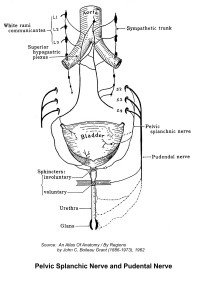
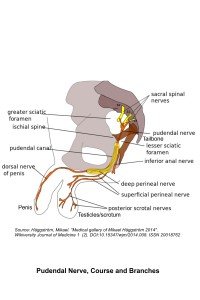
You can stimulate the somatic, vagus and automatic nerves at the same time by massaging the smooth muscle or the transition zone with VIP Cream. Please be aware that directly massaging the smooth muscle can damage it. It is preferred to do it on the transition zone where the mixed tissue is stronger and stiffer than the pure smooth muscle.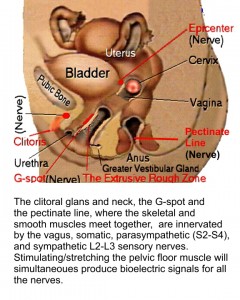
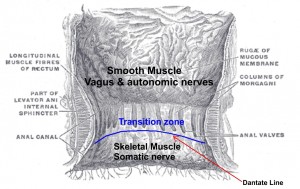 Success requires responsiveness, endurance, and persistence with a short recovery time. VNS can help you become very responsive. You need it in the first place. To extend the VNS effects on your endurance and persistence, you need androgen hormones, such as DHEA, testosterone and DHT, to continuously burn. But, How?; Why?
Success requires responsiveness, endurance, and persistence with a short recovery time. VNS can help you become very responsive. You need it in the first place. To extend the VNS effects on your endurance and persistence, you need androgen hormones, such as DHEA, testosterone and DHT, to continuously burn. But, How?; Why?
The gonadal / androgen hormones are essential for physical and mental strength, but they exert primarily slow, genomically mediated effects. In most of the typical working places such as offices, fields, and/or even bedroom, you may need fast responsiveness and prolonged endurance to achieve your goal and to complete your task. A faster responsiveness with calmness can only be achieved by nervous action from the dopamine, glutamate and serotonin system, with a good blood circulation, provided by the arterial relaxation and dilation from the NO (nitric oxide)- cGMP (cyclic guanosine 3′,5′-monophosphate) signaling pathway, and by stress reduction.
A good blood circulation will continuously supply gonadal hormones to the working muscles (including smooth muscles) and joints to support the physical and mental endurance for your act.
The endurance also requires flexibility of muscles joints without worrying about inflammatory pains. We have found a high dose of Omega-3 Fish Oil (about 3000 mg omega-3 fatty acids) with 81 mg Aspirin is very helpful.
Overall, our products ViaGrowth-IV, MoodMax, DopaFibra, ArgiNOx and Omega-3 Fish Oil can help you to have better responsiveness and endurance and faster recovery.
http://linstitute.apollohosting.com/store/page20.html
http://linstitute.apollohosting.com/store/page24.html
http://linstitute.apollohosting.com/store/page16.html
http://linstitute.apollohosting.com/store/page31.html
By the way, our stress reduction formulas are PinealTonin or 5-HTP, as described in
http://linstitute.apollohosting.com/store/page17.html
Stress reduction can indirectly improve your endurance and directly reduce performance anxiety.
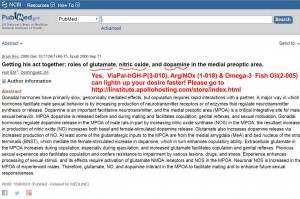 Sex benefit women in many ways which include VNS inside the vagina; on the cervix, uterus and bladder; and on the clitoral shaft and glans, the bulbocavernosus, and the
Sex benefit women in many ways which include VNS inside the vagina; on the cervix, uterus and bladder; and on the clitoral shaft and glans, the bulbocavernosus, and the
ischiocavernosus that contain erectile smooth muscle and are
innervated by the the vagus nerves and parasympathetic
nervous from S2-S4 and sympathetic nerves from L1-L-3.
(References:
1. Larrazolo-López A1, Kendrick KM, Aburto-Arciniega M, Arriaga-Avila V, Morimoto S, Frias M, and Guevara-Guzmán R., ” Vaginocervical stimulation enhances social recognition memory in rats via oxytocin release in the olfactory bulb.” Neuroscience. 2008 Mar 27;152(3):585-93. doi: 10.1016/j.neuroscience.2008.01.024. Epub 2008 Jan 25. http://www.ncbi.nlm.nih.gov/pubmed/18304743;
2. Komisaruk BR, and Sansone G. ” Neural pathways mediating vaginal function: the vagus nerves and spinal cord oxytocin.” Scand J Psychol. 2003 Jul;44(3):241-50. http://www.ncbi.nlm.nih.gov/pubmed/12914587
3. Komisaruk BR, Bianca R, Sansone G, Gómez LE, Cueva-Rolón R, Beyer C, and Whipple B., “Brain-mediated responses to vaginocervical stimulation in spinal cord-transected rats: role of the vagus nerves.” Brain Res. 1996 Feb 5;708(1-2):128-34. http://www.ncbi.nlm.nih.gov/pubmed/8720868 )
Coitus with a hard, hot penis can provide a powerful blending stimulation on the nerves in the cervix, the uterus, and the bladder internally; and on the clitoral shaft and glans, the bulbocavernosus, and the ischiocavernosus, externally when using the 3-point excitation love position (also in http://action.love/WordPress/2014/08/29/aquali-anal-breathing-qigong-induced-erection/ ) or the screwing method (by him) (or by her.)
For men, the VNS stimulation during sex is limited to the penile shaft and glans, the ischiocavernosus around the penile root inside the pelvic floor, and the prostate. 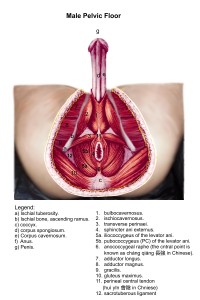
Beside coitus , VNS can be achieved by massaging the acupuncture points, huì yīn會陰 and cháng qiáng 長強 with an insertion of a 0.5-inches finger section into the anus or/and into the vagina (for women), with VIP Cream.
By the way, Anal Breathing QiGong exercises (also in http://action.love/WordPress/2014/11/26/somatic-nervous-function-in-qigong-qi-circulation-how-do-you-circulate-qi/ ) can help you directly stretch the bulbocavernosus (for women) and the ischiocavernosus (for both men and women.). I want you to know Anal Breathing Sexual Qigong Exercises directly link genital organs to the brain, particularly the central dopamine (DA), noradrenaline (NE), and serotonin (5-HT) nervous systems (review papers given in www.mdpi.com/2076-3425/3/1/39/pdf and http://www.ncbi.nlm.nih.gov/pmc/articles/PMC4507374/pdf/jcn-11-212.pdf ) , and the endocrine function for hGH, DHEA, testosterone and DHT production.
Special Reference for the Somato-vagal, Somato-parasympathetic, and Samto-sympathetic Nervous Cross-talk: the stimulation of the pelvic muscles simultaneously activate somato-parasympathetic, somato-vagal and somato-sympathetic reflex arcs (nervous cross-talk in the inter-neurons). ( References: 1. Terui N, and Koizumi K., “Responses of cardiac vagus and sympathetic nerves to excitation of somatic and visceral nerves.” J Auton Nerv Syst. 1984 Apr;10(2):73-91. http://www.ncbi.nlm.nih.gov/pubmed/6747203.; 2. Sato, A., “Neural mechanisms of autonomic responses elicited by somatic sensory stimulation. Neurosci Behav Physiol. 1997 Sep-Oct;27(5):610-21. http://www.ncbi.nlm.nih.gov/pubmed/9353786; 3. Kimura A, and Sato A., “Somatic regulation of autonomic functions in anesthetized animals–neural mechanisms of physical therapy including acupuncture.” Jpn J Vet Res. 1997 Nov;45(3):137-45. http://www.ncbi.nlm.nih.gov/pubmed/9433014; 4. Loaiza LA, Yamaguchi S, Ito M, and Ohshima N., “Electro-acupuncture stimulation to muscle afferents in anesthetized rats modulates the blood flow to the knee joint through autonomic reflexes and nitric oxide. Auton Neurosci. 2002 May 31;97(2):103-9. http://www.ncbi.nlm.nih.gov/pubmed/12132642; 5. Li, J, and Mitchell JH., “Role of NO in modulating neuronal activity in superficial dorsal horn of spinal cord during exercise pressor reflex.” Am J Physiol Heart Circ Physiol. 2002 Sep;283(3):H1012-8. http://ajpheart.physiology.org/content/ajpheart/283/3/H1012.full.pdf; 6. Smith SA, Mitchell JH, and Garry MG., “The mammalian exercise pressor reflex in health and disease.” Exp Physiol. 2006 Jan;91(1):89-102. Epub 2005 Nov 10. http://onlinelibrary.wiley.com/doi/10.1113/expphysiol.2005.032367/full ; 7. Gallagher KM, Fadel PJ, Smith SA, Strømstad M, Ide K, Secher NH, and Raven PB., “The interaction of central command and the exercise pressor reflex in mediating baroreflex resetting during exercise in humans.” Exp Physiol. 2006 Jan;91(1):79-87. Epub 2005 Nov 1. http://onlinelibrary.wiley.com/doi/10.1113/expphysiol.2005.032110/full ; 8. Fadel PJ, and Raven PB.,”Human investigations into the arterial and cardiopulmonary baroreflexes during exercise.” Exp Physiol. 2012 Jan;97(1):39-50. doi: 10.1113/expphysiol.2011.057554. Epub 2011 Oct 14. http://www.ncbi.nlm.nih.gov/pmc/articles/PMC3253263/pdf/nihms332393.pdf )
References:
- http://www.ncbi.nlm.nih.gov/pubmed/26433214
- Pavlov, V.A.; Tracey, K.J. “The vagus nerve and the inflammatory reflex–linking immunity and metabolism.” Nat Rev Endocrinol. 2012 Dec;8(12):743-54. doi: 10.1038/nrendo.2012.189. http://www.ncbi.nlm.nih.gov/pmc/articles/PMC4082307/
- http://www.nature.com/ncomms/2015/150630/ncomms8490/full/ncomms8490.html
- https://www.gdsm.espci.fr/sites/www.gdsm.espci.fr/IMG/pdf/PlacaisPreat2012.pdf
- http://www.ncbi.nlm.nih.gov/pubmed/22608184
- http://www.ncbi.nlm.nih.gov/pubmed/12922929
- http://www.ncbi.nlm.nih.gov/pmc/articles/PMC4473270/
- http://www.ncbi.nlm.nih.gov/pubmed/22561408
- http://www.ncbi.nlm.nih.gov/pubmed/19722820
- http://www.ncbi.nlm.nih.gov/pubmed/20226124
- Ghanem, T; Early, S (2006). “Vagal nerve stimulator implantation: An otolaryngologist’s perspective”. Otolaryngology – Head and Neck Surgery 135 (1): 46–51. doi:10.1016/j.otohns.2006.02.037. PMID 16815181.
- Tzu-Wei Lin and Yu-Min Kuo (2013), “Exercise Benefits Brain Function: The Monoamine Connection” Brain Sci. 2013, 3, 39-53; doi:10.3390/brainsci3010039 (review paper in www.mdpi.com/2076-3425/3/1/39/pdf )
- Thierry Paillarda Yves Rollandb,c Philipe de Souto Barretob (2015) Protective Effects of Physical Exercise in Alzheimer’s Disease and Parkinson’s Disease: A Narrative Review. J Clin Neurol 2015;11(3):212-219 / http://dx.doi.org/10.3988/jcn.2015.11.3.212 –ttp://www.ncbi.nlm.nih.gov/pmc/articles/PMC4507374/pdf/jcn-11-212.pdf
- http://www.ncbi.nlm.nih.gov/pubmed/8026408
- Lenzer J, Brownlee S. Why the FDA can’t protect the public. BMJ. 2010;341:c4753
- http://www.ncbi.nlm.nih.gov/pubmed/26728182
- http://www.sciencedaily.com/releases/2010/11/101102191841.htm
- http://www.ncbi.nlm.nih.gov/pubmed/24870622
- Doctor’s Guide: Vagus Nerve Stimulation Successful For Depression
- Neurology Channel: Vagus Nerve Stimulation
- FDA Summary of VNS Data
- Donovan, Charles E. (2006). Out of the Black Hole: A Patient’s Guide to Vagus Nerve Stimulation and Depression. Wellness Publishers. ISBN 978-0-9748484-3-3
- http://www.ncbi.nlm.nih.gov/pmc/articles/PMC4245370/
- http://center4research.org/nrc-in-the-news/news-analysis-interviews-op-eds-editorials/medical-devices-that-can-kill/
- http://www.ncbi.nlm.nih.gov/pubmed/20950355
- Groves, Duncan A.; Brown, Verity J. (2005). “Vagal nerve stimulation: A review of its applications and potential mechanisms that mediate its clinical effects”. Neuroscience & Biobehavioral Reviews 29 (3): 493. doi:10.1016/j.neubiorev.2005.01.004.
- http://www.ncbi.nlm.nih.gov/pubmed/25556801
- Clinical trial number NCT00294281 for “Vagus Nerve Stimulation for Treating Adults With Severe Fibromyalgia” atClinicalTrials.gov
- Karason K, Mølgaard H, Wikstrand J, Sjöström L (April 1999). “Heart rate variability in obesity and the effect of weight loss”. The American Journal of Cardiology 83 (8):1242–7. doi:10.1016/S0002-9149(99)00066-1. PMID 10215292.
- http://www.utdallas.edu/news/2010/8/9-4791_NIH-Grant-Supports-Profs-Search-for-Tinnitus-Cure_article.html[full citation needed]
- Herremans SC, Baeken C (September 2012). “The current perspective of neuromodulation techniques in the treatment of alcohol addiction: a systematic review” (PDF). Psychiatria Danubina 24 (Suppl 1): S14–20. PMID 22945180.
- Shen MJ, Shinohara T, Park HW, et al. (May 2011). “Continuous low-level vagus nerve stimulation reduces stellate ganglion nerve activity and paroxysmal atrial tachyarrhythmias in ambulatory canines”. Circulation 123 (20): 2204–12.doi:10.1161/CIRCULATIONAHA.111.018028. PMC 3101282. PMID 21555706.
- Sha Y, Scherlag BJ, Yu L, et al. (October 2011). “Low-level right vagal stimulation: anticholinergic and antiadrenergic effects”.Journal of Cardiovascular Electrophysiology 22 (10): 1147–53. doi:10.1111/j.1540-8167.2011.02070.x. PMID 21489033.
- http://www.ncbi.nlm.nih.gov/pubmed/24727611
- Levy ML, Levy KM, Hoff D, et al. (June 2010). “Vagus nerve stimulation therapy in patients with autism spectrum disorder and intractable epilepsy: results from the vagus nerve stimulation therapy patient outcome registry”. Journal of Neurosurgery. Pediatrics 5(6): 595–602. doi:10.3171/2010.3.PEDS09153. PMID 20515333.
- http://www.ncbi.nlm.nih.gov/pubmed/24875100
- http://www.ncbi.nlm.nih.gov/pubmed/24719355
- Faris PL, Eckert ED, Kim SW, et al. (May 2006). “Evidence for a vagal pathophysiology for bulimia nervosa and the accompanying depressive symptoms”. Journal of Affective Disorders 92 (1): 79–90. doi:10.1016/j.jad.2005.12.047. PMID 16516303.
- Niederbichler AD, Papst S, Claassen L, et al. (September 2009). “Burn-induced organ dysfunction: vagus nerve stimulation attenuates organ and serum cytokine levels”. Burns 35 (6): 783–9. doi:10.1016/j.burns.2008.08.023. PMID 19482432.
- Abraham WT, Smith SA (February 2013). “Devices in the management of advanced, chronic heart failure”. Nature Reviews. Cardiology 10 (2): 98–110. doi:10.1038/nrcardio.2012.178. PMC 3753073. PMID 23229137.
- Payne BR, Tiel RL, Payne MS, Fisch B (May 2005). “Vagus nerve stimulation for chronic intractable hiccups. Case report”. Journal of Neurosurgery 102 (5): 935–7. doi:10.3171/jns.2005.102.5.0935. PMID 15926725.
- Effects of Vagus Nerve Stimulation (VNS) as a “Treatment of Persistent Depression With Comorbid Personality Disorders”.,cpapplanet.com
- Zamotrinsky, A. V.; Kondratiev, B.; de Jong, J. W. (2001). “Vagal neurostimulation in patients with coronary artery disease”. Auton. Neurosci. 88 (1-2): 109–116. doi:10.1016/S1566-0702(01)00227-2.
- Spatola M, Jeannet PY, Pollo C, Wider C, Labrum R, Rossetti AO (2013). “Effect of vagus nerve stimulation in an adult patient with Dravet syndrome: contribution to sudden unexpected death in epilepsy risk reduction?”. European Neurology 69 (2): 119–21.doi:10.1159/000345132. PMID 23207687.
- Zamponi N, Passamonti C, Cesaroni E, Trignani R, Rychlicki F (July 2011). “Effectiveness of vagal nerve stimulation (VNS) in patients with drop-attacks and different epileptic syndromes”. Seizure 20 (6): 468–74. doi:10.1016/j.seizure.2011.02.011.PMID 21396833.
- Yamakawa K, Matsumoto N, Imamura Y, et al. (2013). “Electrical vagus nerve stimulation attenuates systemic inflammation and improves survival in a rat heatstroke model”. Plos One 8 (2): e56728. doi:10.1371/journal.pone.0056728. PMC 3570456.PMID 23424673.
- Liu H, Liu Y, Yu J, et al. (April 2011). “Vagus nerve stimulation inhibits heroin-seeking behavior induced by heroin priming or heroin-associated cues in rats”. Neuroscience Letters 494 (1): 70–4. doi:10.1016/j.neulet.2011.02.059. PMID 21362452.
- Krzyzaniak M, Peterson C, Loomis W, et al. (May 2011). “Postinjury vagal nerve stimulation protects against intestinal epithelial barrier breakdown”. The Journal of Trauma 70 (5): 1168–75; discussion 1175–6. doi:10.1097/TA.0b013e318216f754.PMID 21610431.
- http://livingwithlgs.com/vagus-nerve-stimulation.aspx
- Ghacibeh GA, Shenker JI, Shenal B, Uthman BM, Heilman KM (September 2006). “The influence of vagus nerve stimulation on memory”. Cognitive and Behavioral Neurology 19 (3): 119–22. doi:10.1097/01.wnn.0000213908.34278.7d. PMID 16957488.
- Rosenberg O, Shoenfeld N, Kotler M, Dannon PN (June 2009). “Mood disorders in elderly population: neurostimulative treatment possibilities”. Recent Patents on CNS Drug Discovery 4 (2): 149–59. doi:10.2174/157488909788453013. PMID 19519563.
- Jump up^ Polak T, Zeller D, Fallgatter AJ, Metzger FG (March 2013). “Vagus somatosensory-evoked potentials are prolonged in patients with multiple sclerosis with brainstem involvement”. Neuroreport 24 (5): 251–3. doi:10.1097/WNR.0b013e32835f00a3.PMID 23407276.
- Li H, Yang TD (November 2009). “Vagus nerve stimulation may be used in the therapy of myocarditis”. Medical Hypotheses 73 (5): 725–7. doi:10.1016/j.mehy.2009.04.036. PMID 19481875.
- http://www.ocdcentral.info/tag/vagus-nerve-stimulation
- Payrits T, Ernst A, Ladits E, Pokorny H, Viragos I, Längle F (October 2011). “Vagale Stimulation–eine neue Möglichkeit zur konservativen Therapie der peripheren arteriellen Verschlusskrankheit” [Vagal stimulation – a new possibility for conservative treatment of peripheral arterial occlusion disease]. Zentralblatt Für Chirurgie (in German) 136 (5): 431–5. doi:10.1055/s-0031-1283739. PMID 22009541.
- Xiong J, Xue FS, Liu JH, et al. (December 2009). “Transcutaneous vagus nerve stimulation may attenuate postoperative cognitive dysfunction in elderly patients”. Medical Hypotheses 73 (6): 938–41. doi:10.1016/j.mehy.2009.06.033. PMID 19631475.
- Grujic J, Bien CG, Pollo C, Rossetti AO (January 2011). “Vagus nerve stimulator treatment in adult-onset Rasmussen’s encephalitis”. Epilepsy & Behavior 20 (1): 123–5. doi:10.1016/j.yebeh.2010.10.024. PMID 21130042.
- Jump up^ Steinberg H (July 2013). “A pioneer work on electric brain stimulation in psychotic patients. Rudolph Gottfried Arndt and his 1870s studies”. Brain Stimulation 6 (4): 477–81. doi:10.1016/j.brs.2012.11.004. PMID 23266132.
- Jump up^ Kumar V, Sharma A (January 2010). “Is neuroimmunomodulation a future therapeutic approach for sepsis?”. International Immunopharmacology 10 (1): 9–17. doi:10.1016/j.intimp.2009.10.003. PMID 19840870.
- Lyubashina OA, Sokolov AY, Panteleev SS (October 2012). “Vagal afferent modulation of spinal trigeminal neuronal responses to dural electrical stimulation in rats”. Neuroscience 222: 29–37. doi:10.1016/j.neuroscience.2012.07.011. PMID 22800563.
- Hiraki T, Baker W, Greenberg JH (April 2012). “Effect of vagus nerve stimulation during transient focal cerebral ischemia on chronic outcome in rats”. Journal of Neuroscience Research 90 (4): 887–94. doi:10.1002/jnr.22812. PMC 3306061.PMID 22420043.
- Levy G, Fishman JE, Xu D, et al. (January 2013). “Parasympathetic stimulation via the vagus nerve prevents systemic organ dysfunction by abrogating gut injury and lymph toxicity in trauma and hemorrhagic shock”. Shock 39 (1): 39–44.doi:10.1097/SHK.0b013e31827b450. PMC 3547655. PMID 23247120.
- Lopez NE, Krzyzaniak MJ, Costantini TW, et al. (June 2012). “Vagal nerve stimulation decreases blood-brain barrier disruption after traumatic brain injury”. The Journal of Trauma and Acute Care Surgery 72 (6): 1562–6. doi:10.1097/TA.0b013e3182569875.PMID 22695423.
- Kumaria A, Tolias CM (June 2012). “Is there a role for vagus nerve stimulation therapy as a treatment of traumatic brain injury?”.British Journal of Neurosurgery 26 (3): 316–20. doi:10.3109/02688697.2012.663517. PMID 22404761.
- Komisaruk BR, Whipple B, Crawford A, Liu WC, Kalnin A, Mosier K (October 2004). “Brain activation during vaginocervical self-stimulation and orgasm in women with complete spinal cord injury: fMRI evidence of mediation by the vagus nerves”. Brain Research1024 (1-2): 77–88. doi:10.1016/j.brainres.2004.07.029. PMID 15451368.
- Whipple B, Komisaruk BR (2002). “Brain (PET) responses to vaginal-cervical self-stimulation in women with complete spinal cord injury: preliminary findings”. Journal of Sex & Marital Therapy 28 (1): 79–86. doi:10.1080/009262302317251043.PMID 11928182.
- http://clinicaltrialsfeeds.org/clinical-trials/show/NCT01260090
- Zhang X, Cao B, Yan N, et al. (January 2013). “Vagus nerve stimulation modulates visceral pain-related affective memory”.Behavioural Brain Research 236 (1): 8–15. doi:10.1016/j.bbr.2012.08.027. PMID 22940455.
- George, M; Sackeim, HA; Rush, AJ; Marangell, LB; Nahas, Z; Husain, MM; Lisanby, S; Burt, T; et al. (2000). “Vagus nerve stimulation: A new tool for brain research and therapy*”. Biological Psychiatry 47 (4): 287–95. doi:10.1016/S0006-3223(99)00308-X. PMID 10686263.
- “UCLA Develops Unique Nerve-stimulation Epilepsy Treatment; “Brain Pacemaker” Designed as External or Implant Device”(Press release). 2006-07-25. Retrieved 2006-07-26.
- Lenzer J. Watching over the medical device industry. The BMJ. 2009;338:b2321.
- bit.ly/1jWXnNc
- http://www.vnsmessageboard.com/index.php/topic,4476.0.htm
- http://www.vnsmessageboard.com/index.php/topic,3842.0.htm
- http://www.vnsmessageboard.com/index.php/topic,3850.0.htm
- http://www.vnsmessageboard.com/index.php/topic,4008.0.htm
- http://www.vnsmessageboard.com/index.php/topic,4011.0.htm
- http://www.vnsmessageboard.com/index.php/topic,3832.0.htm
- http://www.vnsmessageboard.com/index.php/topic,3862.0.htm
- http://www.vnsmessageboard.com/index.php/topic,3868.0.htm
- Malow, BA; Edwards, J; Marzec, M; Sagher, O; Fromes, G (2000). “Effects of vagus nerve stimulation on respiration during sleep: A pilot study”. Neurology 55 (10): 1450–4. doi:10.1212/wnl.55.10.1450. PMID 11094096.
- Marzec, Mary; Edwards, Jonathan; Sagher, Oren; Fromes, Gail; Malow, Beth A. (2003). “Effects of Vagus Nerve Stimulation on Sleep-related Breathing in Epilepsy Patients”. Epilepsia 44 (7): 930–5. doi:10.1046/j.1528-1157.2003.56202.x. PMID 12823576.
- “HP-5A: Heart Rate and Blood Pressure” (PDF). iWorx Systems Inc. Retrieved 12 May 2014.
- Hsieh, T; Chen, M; McAfee, A; Kifle, Y (2008). “Sleep-Related Breathing Disorder in Children with Vagal Nerve Stimulators”.Pediatric Neurology 38 (2): 99–103. doi:10.1016/j.pediatrneurol.2007.09.014. PMID 18206790.
- Marzec, Mary; Edwards, Jonathan; Sagher, Oren; Fromes, Gail; Malow, Beth A. (2003). “Effects of Vagus Nerve Stimulation on Sleep-related Breathing in Epilepsy Patients”. Epilepsia 44 (7): 930–5. doi:10.1046/j.1528-1157.2003.56202.x.PMID 12823576.
- Vaughn, B; Dcruz, O; Beach, R; Messenheimer, J (1996). “Improvement of epileptic seizure control with treatment of obstructive sleep apneoa”. Seizure 5 (1): 73–8. doi:10.1016/S1059-1311(96)80066-5. PMID 8777557.
- Bernards, Christopher M. (2004). “An Unusual Cause of Airway Obstruction during General Anesthesia with a Laryngeal Mask Airway”. Anesthesiology 100 (4): 1017–8. doi:10.1097/00000542-200404000-00037. PMID 15087642.
- “Vagus Nerve Stimulation”. University of Michigan Depression Center. Retrieved 28 August 2013.
- Hatton, Kevin W.; McLarney, J Thomas; Pittman, Thomas; Fahy, Brenda G. (2006). “Vagal Nerve Stimulation: Overview and Implications for Anesthesiologists”. Anesthesia & Analgesia 103 (5): 1241–9. doi:10.1213/01.ane.0000244532.71743.c6.
- http://www.fda.gov/ohrms/dockets/AC/97/transcpt/3299t1.pdf
- http://www.vnsmessageboard.com/index.php/topic,4117.0.htm
- Tracey, Kevin J. (2007). “Physiology and immunology of the cholinergic antiinflammatory pathway”. Journal of Clinical Investigation 117 (2): 289–96. doi:10.1172/JCI30555. PMC 1783813. PMID 17273548.
- Rosas-Ballina, M.; Ochani, M.; Parrish, W. R.; Ochani, K.; Harris, Y. T.; Huston, J. M.; Chavan, S.; Tracey, K. J. (2008). “Splenic nerve is required for cholinergic antiinflammatory pathway control of TNF in endotoxemia”. Proceedings of the National Academy of Sciences 105 (31): 11008–13Jump up^ Tracey, Kevin J. (2009). “Reflex control of immunity”. Nature Reviews Immunology 9 (6): 418–28. doi:10.1038/nri2566.PMID 19461672.
- ^ Rosas-Ballina, M.; Olofsson, P. S.; Ochani, M.; Valdés-Ferrer, S. I.; Levine, Y. A.; Reardon, C.; Tusche, M. W.; Pavlov, V. A.; Andersson, U.; Chavan, S.; Mak, T. W.; Tracey, K. J. (2011). “Acetylcholine-Synthesizing T Cells Relay Neural Signals in a Vagus Nerve Circuit”. Science 334 (6052): 98–101. doi:10.1126/science.1209985.
- Cyberonics, Inc. (2007.) VNS Therapy Patient Essentials: Depression.
- Panescu, D. (2005). “Emerging Technologies: Vagus Nerve Stimulation for the Treatment of Depression”. IEEE Engineering in Medicine and Biology Magazine 24 (6): 68–72. doi:10.1109/MEMB.2005.1549737.
- Leusden, J; Sellare, R; et al. (2015). “Transcutaneous Vagal Nerve Stimulation (tVNS): a new neuromodulation tool in healthy humans?”. Frontiers in Psychology 6 (102): 287–95. doi:10.3389/fpsyg.2015.00102. PMC 4322601.

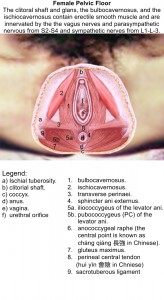
Pingback: Peyronies Disease – Deformation or hardening of genital smooth muscle | Love Blog